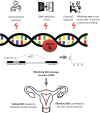Possible modification of BRSK1 on the risk of alkylating chemotherapy-related reduced ovarian function
- PMID: 33582778
- PMCID: PMC7970730
- DOI: 10.1093/humrep/deaa342
Possible modification of BRSK1 on the risk of alkylating chemotherapy-related reduced ovarian function
Abstract
Study question: Do genetic variations in the DNA damage response pathway modify the adverse effect of alkylating agents on ovarian function in female childhood cancer survivors (CCS)?
Summary answer: Female CCS carrying a common BR serine/threonine kinase 1 (BRSK1) gene variant appear to be at 2.5-fold increased odds of reduced ovarian function after treatment with high doses of alkylating chemotherapy.
What is known already: Female CCS show large inter-individual variability in the impact of DNA-damaging alkylating chemotherapy, given as treatment of childhood cancer, on adult ovarian function. Genetic variants in DNA repair genes affecting ovarian function might explain this variability.
Study design, size, duration: CCS for the discovery cohort were identified from the Dutch Childhood Oncology Group (DCOG) LATER VEVO-study, a multi-centre retrospective cohort study evaluating fertility, ovarian reserve and risk of premature menopause among adult female 5-year survivors of childhood cancer. Female 5-year CCS, diagnosed with cancer and treated with chemotherapy before the age of 25 years, and aged 18 years or older at time of study were enrolled in the current study. Results from the discovery Dutch DCOG-LATER VEVO cohort (n = 285) were validated in the pan-European PanCareLIFE (n = 465) and the USA-based St. Jude Lifetime Cohort (n = 391).
Participants/materials, setting, methods: To evaluate ovarian function, anti-Müllerian hormone (AMH) levels were assessed in both the discovery cohort and the replication cohorts. Using additive genetic models in linear and logistic regression, five genetic variants involved in DNA damage response were analysed in relation to cyclophosphamide equivalent dose (CED) score and their impact on ovarian function. Results were then examined using fixed-effect meta-analysis.
Main results and the role of chance: Meta-analysis across the three independent cohorts showed a significant interaction effect (P = 3.0 × 10-4) between rs11668344 of BRSK1 (allele frequency = 0.34) among CCS treated with high-dose alkylating agents (CED score ≥8000 mg/m2), resulting in a 2.5-fold increased odds of a reduced ovarian function (lowest AMH tertile) for CCS carrying one G allele compared to CCS without this allele (odds ratio genotype AA: 2.01 vs AG: 5.00).
Limitations, reasons for caution: While low AMH levels can also identify poor responders in assisted reproductive technology, it needs to be emphasized that AMH remains a surrogate marker of ovarian function.
Wider implications of the findings: Further research, validating our findings and identifying additional risk-contributing genetic variants, may enable individualized counselling regarding treatment-related risks and necessity of fertility preservation procedures in girls with cancer.
Study funding/competing interest(s): This work was supported by the PanCareLIFE project that has received funding from the European Union's Seventh Framework Programme for research, technological development and demonstration under grant agreement no 602030. In addition, the DCOG-LATER VEVO study was funded by the Dutch Cancer Society (Grant no. VU 2006-3622) and by the Children Cancer Free Foundation (Project no. 20) and the St Jude Lifetime cohort study by NCI U01 CA195547. The authors declare no competing interests.
Trial registration number: N/A.
Keywords: childhood cancer; fertility; gonadotoxicity; ovarian reserve; survivorship.
© The Author(s) 2021. Published by Oxford University Press on behalf of European Society of Human Reproduction and Embryology.
Figures

References
-
- Anderson RA, Nelson SM, Wallace WH.. Measuring anti-Mullerian hormone for the assessment of ovarian reserve: when and for whom is it indicated? Maturitas 2012;71:28–33. - PubMed
Publication types
MeSH terms
Substances
Grants and funding
LinkOut - more resources
Full Text Sources
Other Literature Sources
Medical
Research Materials

